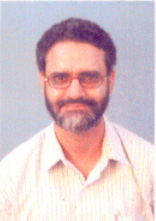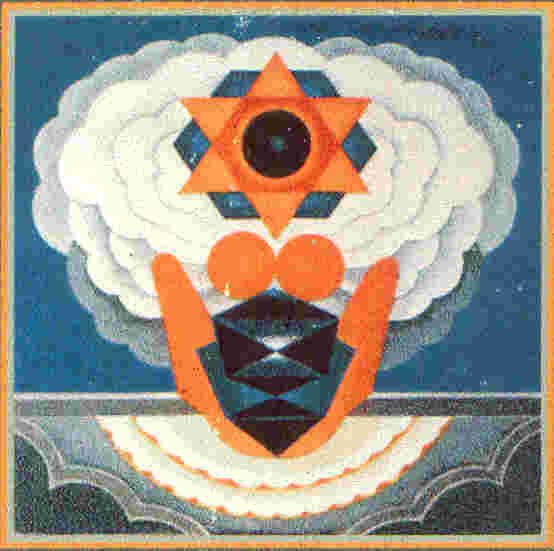|
Milchar
January-February 2004 issue
|

|
Swami
Vivekananda at Kshir Bhawani, Kashmir
|
|
 |
|
Our Heritage Aspects
of Kashmiri Pandit Culture - 2
… Raj Nath Bhat (BHU)
Click: Part 1 |
Part 3
 Marriage Marriage
Several rituals are associated with marriage whose observance begins nearly a week before the wedding day. The bride’s family begins with what is known as
'garnàvay' (literally: get madeup) when the hair of the bride are let loose. This is followed by
'sàtû mänz' (first henna or auspicious henna) when henna is applied to the bride and the groom by their respective mothers and aunts. These rituals are attended by near relatives and
neighbours. 'mänzíràt' (henna night) is the first major event when all the relatives-men, women and children in the extended families assemble at the girl’s and the boy’s respective places. This is a night of much rejoicing and feasting. The evening meal is followed by a series of ceremonial acts. Henna is pasted on the hands and feet of the bride and the groom in their respective places and almost every young boy and all women and girls paste henna on their hands and elderly women sing traditional songs. Before pasting henna, maternal aunt
(maami) washes the feet and hands of the bride and the groom, and the paternal aunt
(bua) applies henna, and the maternal aunt (maasi) burns incence to ward off evil. Meanwhile women, girls and boys sing traditional ditties as well as popular songs appropriate to the occasion.
While the singing, & henna pasting is on, the bride as well as the groom are given a
'kaní shràn' (thorough bath) by aunts and sisters-in-law to prepare them for
'dívgòn', the entrance of Devtas. After the ceremonial bath, the boy and the girl wear clothes brought by their respective maternal uncles. The bride is made to wear
'déjíhòr' - a gold ornament, and 'kalpùsh' -a variety of headgear.
'déjíhòr' is tied to a gold chain known as ‘'ath' which is provided by the groom’s family on the wedding day to complete the holy alliance between Shiva - the groom, and Parvati - the bride.
'dívgòn' is the religious ritual performed after the bath. The family purohit performs a small yajna on this occasion.
'dívgòn', it is believed, transforms the bride and the groom into ‘Devtas’.
On the wedding day, the groom wears a colourful dress with a saffron-coloured turban on his head. He is made to stand on a beautifully made
'vyùg' (rangoli) in the front compound of the house where parents, relatives and friends put garlands made of fresh plucked flowers, of cardamom and currency notes round the groom’s neck. A cousin holds a flower-decked umbrella to protect the groom against evil. Conch-shells are blown, ditties are sung and the groom’s party moves towards the bride’s place usually in cars and other modes of transport.
Conch-shells announce the arrival of the groom and his party at the bride’s place where the lane leading to the main entrance to the house is beautifully decorated with colourful flowers and dyed saw-dust. Upon entering the compound of the bride’s house, the groom is welcomed by traditional songs sung by the bride’s relations. He is put on a rangoli where the bride draped in a colourful silk Saree is made to stand beside him on his left side. There is another round of garlanding from the girl’s relatives. Then the mother of the bride comes with a thali of small lighted lamps made of kneaded rice flour and an assortment of sweets and makes the groom and the bride eat from the same piece of sweet a couple of times. After this the bride is taken back into the house and the groom is made to stand at the main door of the house for a short
'dvàr pùzà' (door prayers). The groom’s party joins the bride’s relatives in a very rich feast. Meanwhile the bride and the groom are seated in a beautifully decorated room for a series of rituals and ceremonies amidst chanting of Sanskrit mantras for several hours with little breaks in between. During these ceremonies, the bride is supported by her maternal uncle. The purohits of the two families recite mantras and make the bride, groom and their parents to perform a number of rituals with fire
(agni) as the witness. The boy and the girl take seven rounds of the agni-kund (spring of fire) and vow to live together in prosperity and adversity, in joy as well as in sorrow, till they are separated by death.
'lågûn', as this ceremony is called, is followed by 'pòshû pùzà' (showering of flowers) in which a red shawl is spread over the bride and the groom, held at four edges by four people, and amidst recitation of shlokas all the elderly people shower flowers on the two ‘devtas’. After this ceremony the bride and the groom are taken to the kitchen and made to eat from the same plate.
A 'vyùg' (rangoli) is laid in the compound and the bride and the groom stand on it. Now the bride joins the groom to the groom’s place where yet another rangoli is laid and the bride and the groom are made to stand on it. Here the groom’s party relaxes and the bride is made to
wear'ath'', the gold chain which is attached to 'déjíhòr'. Her hair and head-gear
'tarûngû' are tied and she is made to wear a saree given to her by the groom’s family.
After this they return to the bride’s place with a small party comprising the groom’s father, brothers, sisters, brothers-in-law, and a couple of friends. As a member of her new family, she is now a guest at her parent’s place. The groom’s party asks the bride’s parents to send her (the bride) to her family (the in-laws). After a little tea, the party leaves for the groom’s place. A younger brother/sister/cousin of the bride accompanies the party to the groom’s place. On the next day or a couple of days later depending upon the mahoorat (auspicious day), the newly married couple visit the wife’s parents. This visit is known as
'satràt' or 'phírsàl'. Upon reaching the wife’s parent’s place, the man and wife are welcomed with
'àlat' - a thali with water, rice, coins and flowers.
The nuptials in their utterances, promises, and hopes symbolize a great social transition in the life of the bride and the bridegroom. They have to earn their own livelihood, procreate children and discharge their obligations towards Gods, parents, children and other creatures of the world. The nuptial ceremonies these address all aspects of married life: biological, physical, and mental.
During the first year after marriage the girl’s parents send gifts to the groom’s place on a number of occasion in the form of cash, clothes, sweets, fruits, & cooked food. Gifts are sent on the birthdays of the groom, the bride & groom’s parents; prasad in the form of wanlnuts and baked bread etc. on Shivratri
(hèrats bòg), fruits, sweets etc. on Janamashtami and Diwali; 'pôlàv' etc. on
'khétsí màvas'; During the month of Magar a special ceremony known as 'shíshúr' is solemnized when the bride is provided with a special
'kàngûr'-a brazier used during winter, and 'shíshúr' (til seeds wrapped in a piece of silk) is tied on her upper garment. On this day, near relatives, especially women, of the groom’s family are invited and the girl’s parents send gifts in the form of clothes, cash, to their daughter.
lath môklàvûni :
During her first pregnancy, the girl’s parents invite her to their home, and after a little
puja, she is made to wear a new headgear 'tarûngû'. Then accompanied by a sister / cousin, she goes back to her home with milk, clothes, cash, baked bread & other gifts.
sôndar :
On the seventh day after delivery, the mother and the baby are given a hot bath. Special vegetarian / non-vegetarian dishes are prepared on the
occasion. Pieces of paper or 'búrzû' (birch bark) are burnt in an earthen plate and circled thrice round the heads of the mother and the baby to ward off evil. Seven plates of special food are served to the paternal aunts of the baby. This is exclusively a women’s ceremony. On this day the mother’s parents send ‘trûy
phót' (wife’s basket) which contains clothes, rotis, sugar, spices, cash for the newborn, and its parents and grandparents.
kàh nèthar :
This is the religious ceremony of purification. On the 11th day after childbirth, a small ‘hawan’ is performed in the house and a tilak is applied on the forehead of the newborn . The baby’s maternal grandparents send clothes on the occasion. This ends
'hòntsh' (impure effect) in the family.
On the 12th day the baby is put on a rangoli laid in the house-threshold (porch) and a piece of sweet is touched to its lips, the family elders shower blessings on the baby. The baby & the mother visit its maternal grandparents where they may stay for a few days. On their return, the grandparents send baked items mutton preparations, curds, milk & clothes for the baby, its parents and paternal grandparents.
mèkhlà or mèkhal :
In the past the sacred thread ceremony of boy was performed when he would become seven years old, i.e. when he would be able to wash the sacred thread
'yòní' (jeniv) and recite the “Gayatri Mantra”. Usually, all the boys in the family are made to wear the sacred thread together in a single ceremony.
'mèkhlà' or yajnopavit involves all the ceremonies and rituals, like 'mänzíràt',
'dívgòn'' etc. associated with a marriage ceremony. After 'dívgòn' the boys' (called
'mèkhlí mahàràzû' - mekhla grooms), heads are shaven and they are made to wear
saffron-coloured robes.
Mothers, and paternal aunts wear red and white thread 'närívan' on their ears and a huge agni-kund’ is prepared where seven purohits recite vedic mantras for nearly 12 hours and ghee,
jaggery, rice and paddy are constantly poured into the agni-kund to please the devtas and seek their blessing. For the whole day relatives and friends come to this ‘'Hawan
Pandal' and the eldest of the 'mèkhlí mahàràzû begs of them to give
'dakshínà' (offerings) for the gurus (the purohits), which the visitors are pleased to give him
'åbìd' (dakshina). Towards the evening the family-purohit asks the father of the mekhla grooms to put the sacred thread on them. This is a very emotional moment for the purohits as well as the father, the members of the family, and relatives. The chanting of mantras rises to the highest pitch and the
mekhla-grooms are made to wear the sacred thread, marking their entrance into the pure brahmanical fold. This begins their brahmachari period, the first stage of Hindu life, when they seek only knowledge and wisdom. After this the Guru
(family-purohit) whispers the Gayatri Mantra into the ears of the mekhla grooms. They are directed to recite this mantra every morning after taking a bath.
Once the yajna is concluded, the maternal uncle(s) of the mekhla –grooms takes them to a nearby temple. Meanwhile prasad in the form of rice, cereals, vegetables is served to all the relatives and friends including the mekhla grooms, and their parents who observe a fast for the whole day.
The next day (kôshalhòm) is observed as a day of feasting when mutton preparations are served. A day or two later, depending upon the position of the planets, sweet rice
'khír' is prepared and a small puja held. After this the mekhla-grooms are made to put on a new sacred thread and the mothers and the aunts remove the
'närívan'. This brings to an end the rituals connected with the yajnopavit ceremony.
- To be continued
| |
 |
|





 Marriage
Marriage 

